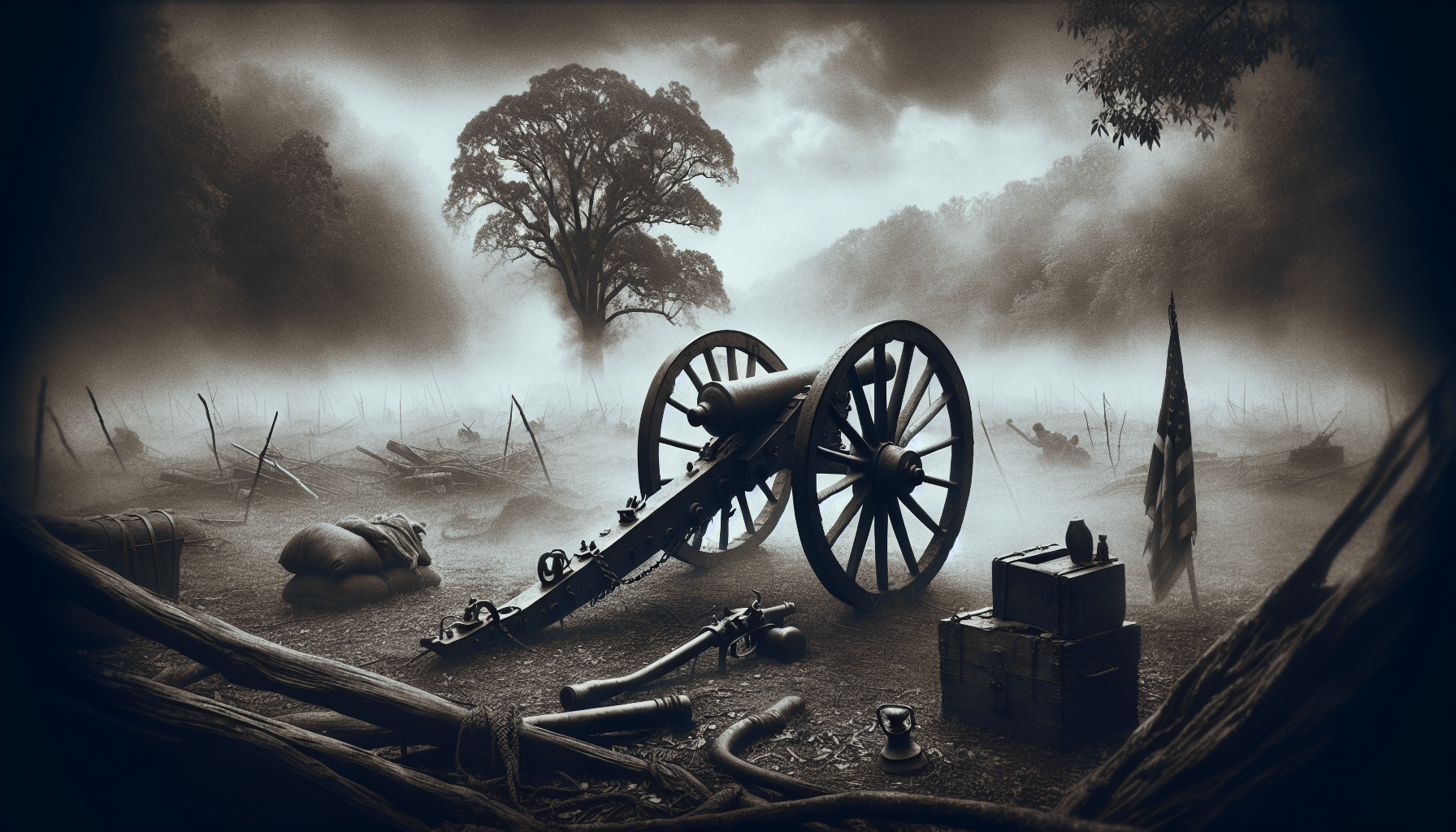The Battle of Shiloh, conducted on April 6 and 7, 1862, stands as a significant conflict within the early stages of the American Civil War, primarily due to the staggering casualties and its strategic implications. Located in southwestern Tennessee, this confrontation unfolded between Union forces, led by Major General Ulysses S. Grant, and the Confederate troops under the command of General Albert Sidney Johnston—who would ultimately die during the battle—and General P. G. T. Beauregard. The Union’s objective to consolidate power in this region was met with a surprising and fierce Confederate assault, marking the battle as one of the war’s bloodiest engagements.
An examination of the key events, command decisions, and the aftermath reveals the complexity of military strategy and the brutal realities of warfare. Initial Confederate successes gave way to Union resilience, resulting in a reshaping of the battlefield. The staggering casualty rates—approximately 13,047 Union and 10,699 Confederate losses—underscore the intense nature of the fighting, while highlighting the significance of Shiloh as a pivotal moment in the trajectory of the Civil War, foreshadowing the prolonged conflict that lay ahead.
Overview of the Battle of Shiloh
Definition and importance of the Battle of Shiloh
The Battle of Shiloh, also referred to as the Battle of Pittsburg Landing, constitutes a significant episode within the annals of the American Civil War. It was marked not only by one of the earliest and bloodiest clashes between Union and Confederate forces but also by its profound implications for subsequent military engagements and strategies employed during the war. The confrontation, characterized by its intensity and high casualty figures, compelled both sides to confront the brutal realities of war, ultimately altering the trajectory of the conflict.
Date and location of the battle
Fought over the two days of April 6-7, 1862, the Battle of Shiloh occurred in southwestern Tennessee, with its central point being the vicinity of the small, unassuming Shiloh Church and the nearby Pittsburg Landing on the Tennessee River. This geo-strategic location served as a critical junction for Union supply lines and troop movements, making it essential for both the Union and Confederate forces.
Significance in the context of the Civil War
The significance of the Battle of Shiloh cannot be understated. It represented a pivotal moment in the Civil War, illustrating the transformation from traditional warfare, characterized by relatively low casualties, to the brutal nature of modern combat that would define the conflict. The outcome not only solidified the Union’s presence in the Western Theater but also showcased the necessity for improved command structures and battlefield coordination amongst the armies.
Background Leading to the Battle
Union victories at Fort Henry and Fort Donelson
The sequence of events leading to the Battle of Shiloh was underscored by notable Union victories at Fort Henry and Fort Donelson in February 1862. These victories cultivated a sense of momentum for Union forces, enabling them to advance further into Confederate territory and establish a foothold along vital transportation routes. These successes invigorated Union morale, and an aggressive strategy emerged aimed at consolidating forces to capitalize on their recent gains.
Strategic importance of Pittsburg Landing
Recognizing the strategic importance of Pittsburg Landing, Union General Ulysses S. Grant aimed to utilize this location as a staging ground for future offensives, including the ultimate capture of Corinth, Mississippi. This strategic insight into the role of transportation routes within Tennessee was vital, as controlling them would allow for the movement of troops and supplies necessary for sustained military campaigns.
Initial movements leading to the confrontation
In the lead-up to the confrontation, intelligence reports about Confederate troop movements sparked concern among Union commanders. While initial reconnaissance did lead to some apprehension, the prevailing sense of confidence among Union leadership led to complacency that would later prove to be detrimental. In contrast, Confederate leaders, recognizing their vulnerability, opted for a pre-emptive strike to capitalize on Union disarray.
Key Commanders

Union commander Major General Ulysses S. Grant
Union forces were commanded by Major General Ulysses S. Grant, whose leadership style and tactical approach would play central roles during the Battle of Shiloh. Grant’s reputation for resilience in the face of adversity had already become cemented following earlier victories. Nevertheless, the battle would test his decision-making and command under extreme pressure as he sought to rally his troops amid chaos.
Confederate commanders General Albert Sidney Johnston and General P. G. T. Beauregard
On the Confederate side, the battle was initially led by General Albert Sidney Johnston, whose strategy revolved around a surprise attack aimed at disrupting Union forces before they could organize. Johnston’s prowess would be called into question, however, following his death during the battle; his replacement, General P. G. T. Beauregard, would also face significant challenges in maintaining control over a disorganized army.
Impact of leadership on battle dynamics
The differences in leadership styles and experience between Union and Confederate commanders significantly influenced the outcome of the battle. Grant’s adaptability in crisis contrasted sharply with the Confederate difficulties in coordination. The sectional battles for authority and communication hampered the Confederate response once Johnston fell, allowing Union forces to regroup and respond to evolving threats.
Preparation and Initial Movements
Union forces’ strategic deployment
In anticipation of an impending Confederate assault, Union forces underwent strategic deployments. Grant organized his troops in readiness along the Tennessee River, emphasizing the establishment of defensive formations. The unanticipated setback of troop allotment due to rapidly unfolding circumstances during this initial stage reflected the challenges faced by the Union side as they sought to confront a confounding Confederacy.
Confederate surprise tactics
The Confederate strategy relied heavily on surprise and swift action, as troops aimed to catch the Union forces off guard. However, this intended operational advantage was compromised by delays caused by logistical issues and adverse weather conditions, resulting in a disjointed execution of the attack plan. Consequently, confusion reigned among Confederate ranks, undermining the anticipated momentum of the surprise.
Preparations leading up to the engagement
The hours leading up to the battle were characterized by final preparations and mutual underestimations between both military forces. As Union scouts alerted their generals to potential threats, Confederate commanders struggled with executing their announced strategy. The tactical landscape became increasingly fraught with uncertainty and miscommunication, foreshadowing the chaotic nature of the ensuing conflict.
Battle Overview

Timeline of the battle beginning April 6, 1862
The Battle of Shiloh commenced early on the morning of April 6, 1862, as Confederate forces launched a general assault against Union positions. The initial strike sought to exploit Union weaknesses; however, the unfurling combat narrative would soon evolve into a fiercely contested battlefield as both armies vied for control.
Initial Confederate attacks and Union response
Initially, the Confederate attacks caught Union forces unprepared, leading to early territorial gains and widespread disarray among Union troops. However, as the battle progressed, Union leaders took decisive steps to regroup and establish defensive lines. The response, despite initial setbacks, demonstrated the adaptability of Union leadership under pressure, characterized by their ability to collect themselves amid chaos.
Key geographical features influencing combat
Key geographical features, notably the Sunken Road, significantly influenced the battle’s dynamics. As this natural depression became a focal point for intense fighting, its strategic advantages became evident. The terrain encapsulated not only tactical opportunities but also psychological impacts on troop morale, allowing the Union army to bolster its defenses amidst an onslaught of Confederate attacks.
Key Events During the Battle
Significant assaults and counterattacks
The battle witnessed an escalating series of significant assaults and counterattacks as both sides sought to seize control of critical locales. Confederate forces exerted substantial pressure on Union defenses, prompting counteroffensives designed to reclaim lost ground. The ebb and flow of engagement highlighted the volatility of battlefield control, with neither side willing to relent.
Major miscommunications and delays on the Confederate side
Confusion marred Confederate efforts due to significant miscommunications and delays in command. As the day progressed, the once-organized Confederate plans began to deteriorate, plagued by officers unable to coordinate forces effectively at a pivotal moment. These disruptions resulted in a fragmented army struggling to maintain its assault momentum, paving the way for potential Union resurgence.
Establishment of Union defensive lines
The establishment of Union defensive lines was instrumental in altering the battle’s trajectory. While initially caught off guard, the determination of Union leaders to reorganize and fortify positions led to critical moments of resilience. The consolidation of forces around the Sunken Road offered a renewed sense of purpose for Union troops, channeling losses into a focused defense that would ultimately prove advantageous.
Casualties and Impact on Forces

Estimated casualty figures for Union and Confederate forces
The Battle of Shiloh resulted in staggering casualty figures, with an estimated 13,047 Union soldiers and 10,699 Confederate soldiers falling as casualties. These decisive figures underscored the battle’s ferocity and the high human cost associated with the Civil War. Both armies grappled with the harrowing reality of warfare, which would resonate throughout the conflict.
Effects of casualties on troop morale
The impact of casualties on troop morale was profound across both military organizations. For the Union, the losses provoked a mix of despair and resilience, yet the final days of the battle rallied a determination to push forward. Confederate forces, meanwhile, faced a dual crisis—a significant loss of life and the death of their commanding general, further dampening morale sharply at a crucial moment in the conflict.
Long-term implications of the battle’s toll
The long-term implications of the battle’s toll affected strategic planning and military engagement throughout the war. The staggering loss of personnel and resources led to a reevaluation of combat strategies on both sides, enshrining the lessons learned at Shiloh into the fabric of military doctrine as armies sought to adapt policies to enhance coordination and operational effectiveness.
Aftermath of the Battle
Conclusion of the two-day battle
The two-day battle concluded with Union forces launching a final counterattack on April 7, 1862, which forced Confederate troops to withdraw from the battlefield. This withdrawal marked not only a tactical defeat for the Confederacy but also a significant gain for Union forces striving to establish command over critical territories in the Western Theater.
Immediate effects on Confederate and Union forces
In the immediate aftermath, the effects reverberated within both Confederate and Union forces. The Union’s victory propelled a sense of renewed vigor among troops, while the Confederate retreat from the battlefield fostered a realization of the necessity for operational reform and restructuring, particularly in terms of command and coordination moving forward.
Strategic lessons learned and changes in tactics
Strategic lessons emerged in the wake of the engagement as military leaders on both sides sought to analyze failures and successes. The lessons of Shiloh sparked an evolution in tactics—enhanced emphasis on reconnaissance, communication protocols, and coordinated assaults gained prominence in military planning. This adaptive learning served as a precursor to future engagements throughout the Civil War.
Historical Significance
The Battle of Shiloh as a pivotal moment in the Civil War
The Battle of Shiloh is often heralded as a pivotal moment in the Civil War narrative, crystallizing the shift in wartime strategies and command dynamics that would come to define subsequent conflicts. As casualty figures soared, it challenged the romantic notions of warfare, ushering in a new era characterized by a more pragmatic, brutal understanding of military engagements.
Influence on future military engagements in the Western Theater
The repercussions of the Battle of Shiloh extended far beyond its initial aftermath, influencing future military engagements within the Western Theater. The lessons gleaned from the battle guided commanders in subsequent confrontations, shaping their tactical responses and strategic outlook as they grappled with the challenges of evolving combat scenarios.
Legacy of the battle in American history
In the greater context of American history, the Battle of Shiloh stands as a reminder of the complexities of war and the enduring impact it had on national identity. Its legacy reveals not only the human cost of the conflict but speaks to the indelible lessons confronted by military leaders navigating the turbulent dynamics of the Civil War era.
Conclusion
Recap of the battle’s importance
In conclusion, the Battle of Shiloh marked a significant turning point for both Union and Confederate forces within the Civil War. The engagement underscored the evolution of warfare, while simultaneously revealing the human costs associated with such confrontations.
Reflection on its impact on the Civil War’s trajectory
As you reflect upon the impact of the Battle of Shiloh, you will surely come to appreciate its role as both a revealing and transformative moment. The implications echoed through subsequent battles and campaigns, altering the methods employed by military leaders across both sides of the conflict and transforming the public perception of the war itself.
Final thoughts on lessons learned from Shiloh
Ultimately, the lessons learned from Shiloh extend beyond mere strategy and tactics, delving into the realms of leadership, logistics, and the human experience of war. The echoes of this battle resonate in military history, reminding you of the importance of adaptability, resilience, and the unyielding spirit amid adversity within the theater of conflict.
